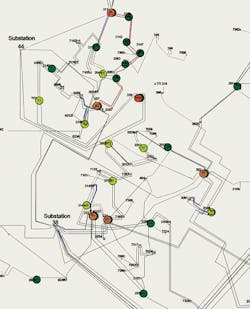Russia’s First Smart City
Smart grid development is now a global strategy that offers the opportunity to establish a high-quality, reliable and energy-efficient power supply. Therefore, it is vitally important to understand, analyze and take advantage of the experience of utilities that have successfully implemented and undertaken the modernization of the electrical infrastructure in large cities with the integration of smart grid technologies. This was Russian Joint Stock Company, Bashkirian Power Grid Co.’s (JSC BPGC’s) focus when it made the decision to create a smart city.
Ufa, the capital of the Republic of Bashkortostan, Russia, is a large industrial city with a population of more than 1 million and forms part of the Volga federal district. The JSC BPGC distribution network consists of several voltage levels (10 kV, 6 kV and 0.4 kV) and 110-kV and 35-kV primary substations. The design of the low-voltage 10-kV and 6-kV underground cable networks are based on radial feeders in seven geographical regions. The monitoring and operation of the distribution substations are partly controlled in real time from an operational information complex (OIK dispatcher).
The existing level of remote control is limited to some key 10-kV and 6-kV switching substations, but there is no remote control or automation facilities in the 10/0.4-kV and 6/0.4-kV distribution transformation substations. Hence, this lack of operational capabilities adversely affects the management of asset maintenance and restoration of supply in the event of faults on the 10-kV and 6-kV networks. The need for these operational facilities is typical for most large cities in the Russian Federation and the republics of the Commonwealth of Independent States (CIS), which are now seen to lag best world practice.
Performance Statistics
Power-quality and reliability indices in Russia and the CIS, particularly for the JSC BPGC distribution network, were compared to those recorded by electric utilities in developed countries. This comparison revealed the following key problems with electricity infrastructure in large cities in Russia and the CIS countries:
- Low reliability caused by complicated topology, resulting in difficulties with fault location, faults that extended to large sections of the network and limited reliability of back-feeds
- Absence of telemetry on many network assets.
- Lack of remote control and the impossibility of control standardization.
- Excessive system losses.
- Aging T&D equipment.
Based on the comparative assessment, these smart grid technology elements were considered most critical for the JSC BRGC network:
- Network optimization achieved by installing modern switchgear.
- Network automation and provision of remote control.
- Automation of supervisory control.
- Installation of smart metering systems.
- Information security in substations.
For the purpose of comprehensive modernization, it is reasonable to integrate smart grid technologies that ensure maximum technical and economic benefits for limited capital resources.
Feasibility Study
Therefore, JSC BPGC management decided to develop a provisional feasibility study (PreFS) of the city’s distribution network infrastructure modernization in a project designed to integrate smart grid technologies. Following is a breakdown of the works performed within the scope of the project PreFS:
- Source data collection and city power network modeling.
- Network current state analysis using the created model.
- Power network development scenarios with creation of network models, including automation technologies for each scenario.
- Technical and economic comparison of scenarios.
- Planning the transition from the current situation to the target model of the power network.
The key stages of the PreFS development was network modeling and analysis followed by the creation of a power network model based on the collected source data in Siemen’s PSS SINCAL program, a planning tool for the simulation, evaluation and optimization of supply systems. The analysis results of the network development identified several power network development scenarios that included topology optimization, voltage-level change, remote control and monitoring of the network, supervisory control and data acquisition (SCADA), distribution management system (DMS), gas-insulated switchgear (GIS) and smart metering.
For the purpose of quantitative analysis of the measures for the city of Ufa, the required capital investment and anticipated economic benefits were estimated. After assessing the economic efficiency of the measures, the most preferable ones were selected. Based on the results of the technical and economic analyses, the optimization and automation of the current network combined with the creation of a smart metering system were recognized as the best solution for Ufa’s distribution network infrastructure modernization project.
Road Map Development
Within the scope of the works performed at the PreFS stage, a detailed plan of the transition from the current situation to the target model was developed along with making an activity progress chart and detailed assessment of the required capital investment. The PreFS target model established criteria to provide remote control and monitoring for distribution switching substations (DS) and distribution transformer substations (TS) as required for full-scale operation in the smart grid model.
The road map described in detail the different stages required for implementation of the selected scenario, including technical improvements of the network structure, automation solutions such as feeder condition monitoring, remote control elements, additional SCADA functionality and smart metering technology.
Pilot Project Implementation
Smart grid project implementation for a city presents a challenging engineering problem. Because this is the first such project implemented to date in Russia, JSC BPGC decided to implement a pilot project for distribution network modernization in Ufa with the integration of smart grid elements. This would enable the utility to identify the best technical solutions before launching the main project for the city, which was planned over a five-year period.
The pilot project has been implemented on a section of the 6-kV network in the eastern district of the Ufa power network. With a population of 8100, this district covers a large residential area—with 38 multistory and multi-entrance apartment blocks as well as residential houses on three streets—nurseries and secondary schools, network heating facilities, public services, bank branches and shops.
The pilot project included the following:
- Double-circuit 10/6-kV underground cable system to connect two DS and seven TS in the distribution network section subject to upgrading.
- Replacement of obsolete 6-kV and 0.4-kV switchgear with new units offering equipped controllability functions as well as a high level of safety and reliability.
- Commercial power metering devices.
- Communication and data exchange system using fiber-optic communication lines (FOCL) connected to the DS and TS substations
- SCADA system for supervisory control of the Ufa distribution networks with a collective data display function.
The main technologies installed for this pilot project included medium-voltage GIS substations, distribution automation technologies—for example, feeder conditions monitoring (FCM) with communication and remotely controlled disconnectors—and modern network control using state-of-the-art software and control room equipment. The existing historically installed network has been optimized, focusing on the modernization and extension of the 10-kV network components, smart metering and meter data management (MDM).
For maximum reliability and efficiency, special equipment was installed in the network control center to monitor network loads and control the switchgear installed in the smart grid section of the distribution network.
Along the Way
The pilot project is now complete. During the implementation process, JSC BPGC specialists developed an innovative approach to the operational control of the entire city network when 25% of the distribution assets were decommissioned for reconstruction.
The utility realized significant benefits from the pilot project, including a substantial reduction in system outages as confirmed by the recorded reliability statistics:
- Reduced time taken for switching by 70%.
- Reduced time taken to locate cable and faults to restore supplies from 2.5 hours to several minutes.
- Reduced system average interruption duration index (SAIDI) from 0.471 hr to 0.083 hr.
Major Challenges
It is important to record the challenges that had to be addressed during the pilot project implementation. Adopting the Western approach to network management created some problems because of the complexity of the selected solution, which did not account for all the specific features of Russian city distribution networks. Following consideration of all the issues, JSC BPGC decided to focus on modern standards, selecting the IEC 61850 protocol for data transfer.
During the construction period, the following difficulties occurred:
- High dependence on the equipment manufacturing time.
- Delays with switchgear delivery.
- Mounting difficulties caused by equipment complexity.
- Complicated responsibility matrix between JSC BPGC and the equipment suppliers during the commissioning process.
- Substantial capital cost overrun against the originally planned budget.
To mitigate these problems, JSC BPGC decided to organize the production of distribution network equipment in the future. Therefore, to implement the Ufa distribution network modernization project using the smart grid technologies pursuant to the agreement between JSC BPGC and Siemens AG, assembly of smart switchgear will be organized in the Republic of Bashkortostan. Also, all the switchgear secondary circuits will be assembled by JSC BPGC.
The prime cost analysis for technically identical switchgear proved the cost of the Type 8DJH 630A GIS manufactured by JSC BPGC, and Siemens is competitive with low-end equipment while its quality is similar to more expensive solutions. Organization of its own production will enable JSC BPGC to reduce the capital investment required for the project and establish a competence center for subsequent smart network technology replication in other cities.
Ufa Network Modernization
Based on the data obtained from the pilot project, plans are now in place to modernize the distribution network for the entire city of Ufa. The transition plan from the current situation to the target model is scheduled to extend over the next five years. This project will involve the modernization and automation of 512 DS and TS, providing operational control facilities and power-flow monitoring, updating the existing Ufa network control center with the integration of SCADA and management systems as well as installing 80,000 metering devices.
Following are the estimated benefits attributable to this major modernization project:
- 80% reduction in the current level of commercial losses.
- 30% reduction in the current level of technical losses.
- 50% reduction in the current number of customer outages attributable to distribution network faults.
- Saving 70% of time for fault location and network switching as a result of remote control facilities and load flow data available to load dispatchers.
- 10% extension in the life of existing equipment in service.
Suitable and Applicable
The JSC BPGC pilot project for the distribution network in Ufa has proved the industry’s control and monitoring technologies are suitable and applicable for all Russian city distribution networks. The project confirms it is preferable to conduct a feasibility study at the outset followed by a pilot project to ensure successful implementation.
JSC BPGC developed an innovative approach to identify automation solutions based on equipment from different manufacturers. The utility is the first in Russia to implement a smart network integration project. The successful JSC BPGC experience in the implementation of modernizing distribution network infrastructure, using smart grid technologies and manufacturing the necessary modern equipment in the Republic of Bashkortostan, is of great importance. As a result, the prospects are good for future distribution network modernization in other cities in the Russian Federation and CIS countries.
Acknowledgement: The authors wish to acknowledge the technical support given by Dr. Holger Müller of Siemens AG and A.Y. Makarov of JSC Sitronics Cams in the preparation of this article.
About the Author
Alexandrovich Yuri Radygin
Alexandrovich Yuri Radygin ([email protected]) was awarded a master’s degree in economics from the Ufa State Aviation Technical University (USATU) in 2008 and a Ph.D. degree in economics in 2010 from USATU. From 2010-2013, he held the position of chief specialist in the departments of strategic development and project management at Joint Stock Company (JSC) Bashkirian Power Grid Co. Since then, Radygin has held the position of head of the investment department and currently he is deputy director of Prospective Development LLC as well as project manager for smart grids.
Guzel Ayratovna Gromova
Guzel Ayratovna Gromova ([email protected]) has an engineering degree in electrical systems and grids, a master’s degree in economics and an economist-manager degree all awarded by the Ufa State Aviation Technical University (USATU) from 2013 to 2015. Since 2015, Gromova has held the position of chief economist of the development department at Joint Stock Company (JSC) Bashkirian Power Grid Co. and is a project administrator for smart grids.





